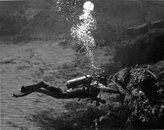If you are diving a dry suit, you should not have to use a BCD (Buoyancy Control Device), as you don’t have wet suit compression to deal with. Yes, add air to the dry suit to prevent squeeze, but all that means is that you are already compensating for the suit. The BCD is not necessaary for this compensation, as you are already doing it by adding air to the dry suit. We used to dive dry suits without a BCD, and we were neutral in the water too. The photo below is of me in an Aquala dry suit, sans BCD, as the BCDs had not yet been invented in 1974.





